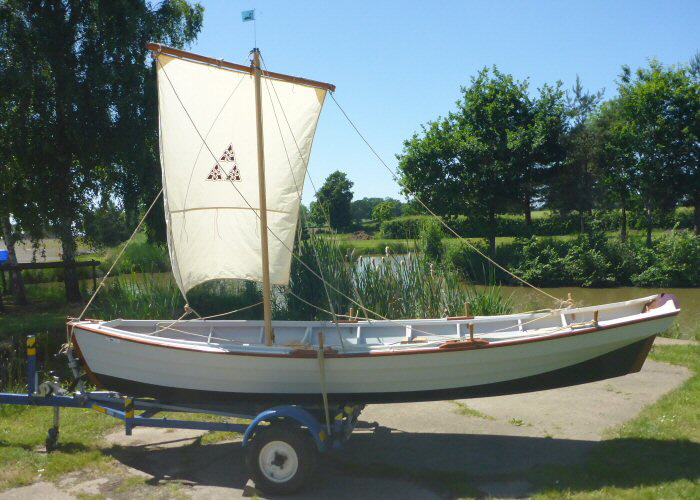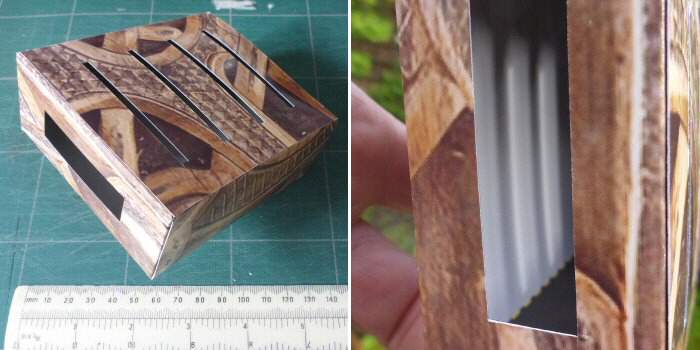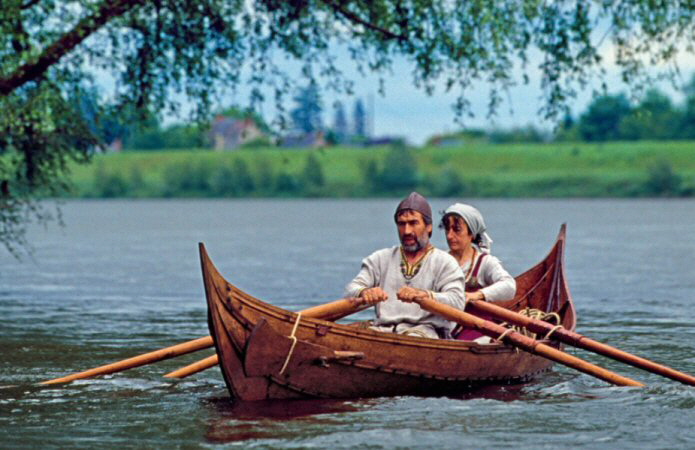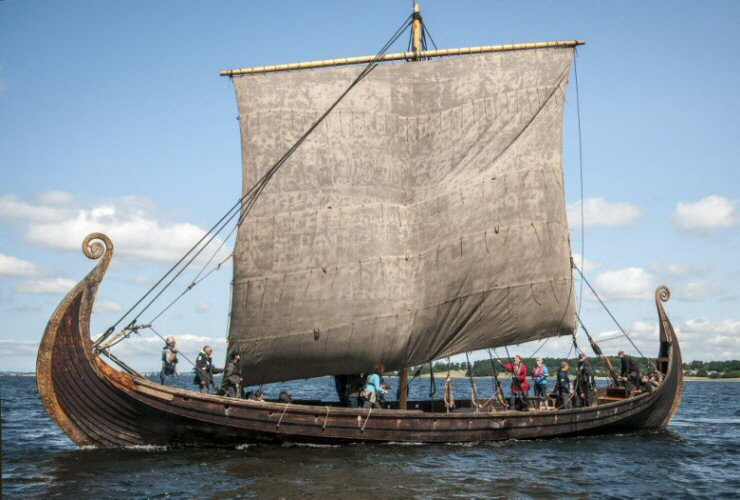 |
|||
|
|||
|
|||||||
Documenting the Stages in Building a Replica of a Viking Boat from about 1130ADI have been intending to build a replica Viking boat for some time. In September 2023 I visited Roskilde, in Denmark, where the Viking Boat Museum and Boatyard show off their craft and archaeology. They provide wonderfully well-organised experiences for visitors - from rowing and sailing a Viking Longboat, to building your own model, watching the current boat-building project or marvelling at the displays in their museum. They have a good café too! I was hosted by Tríona Sørensen (curator) and Martin Dael (boatyard foreman) and was permitted to work with Martin and his team on the shaping and trial fitting of the first garboard to the keel of another replica of a ‘Skuldelev-5’ ship. When I asked him which Viking boat he would suggest to build, he suggested a smaller boat and mentioned their Open Source Gislinge Project where they published plans for a fishing boat - 7 metres (23 feet) long. It looks rather like the one below - which is on permanent display in Waterford in southern Ireland. My intention was to scale the Gislinge boat down to about 5.2-metres (17-feet) long. This blog documents my progress in exploring the options - it hasn’t turned out quite as I had expected; read on for more!
A Viking Longboat at Waterford in Ireland (Vadrarfjord is Nordic for Waterford). The most recent posts are at the top of the blog - the page navigation links below are to help you to find topics of interest. [Note: Photographs in the blog were taken by the author unless otherwise stated] 2023September, Roskilde visit. October, design and scaling. November, strongback and keel. December, design rethink. 2024February: Oseberg model research. March: Oslo visit to check. April: results of the decisions. May: How to make a Viking Navigation ‘Sunstone’. June: Viking rigging for the Irish Gandelow. July: Project stalled.
2024 August - Project on-hold till Spring 2025 ...
2024 JulyMy intention was to trial the Viking-style sail and rigging this month in, hopefully, Ireland or France. However, the UK’s DVLA (Driver and Vehicle Licensing Agency) has been incredibly inept and, despite having had the necessary documents for months, have not yet issued my replacement licence. Without it I can’t go abroad. Welcome to Broken Britain - the previous (Tory) government’s legacy! 2024 JuneIn May and June I have been experimenting with Viking-style rigging on an Irish Gandelow. It has worked out very well. I have followed the guidance in Vibeke Bischoff’s book on the Viking ship ‘Saga Oseberg’. I’ve not yet had a chance to test the rigging with the boat on the water as there are still some details to work out ... such as: a) does it need a lee-board, and b) does it need a rudder fixed Viking style (or is an oar over the stern good enough)? More on all this later. Meanwhile, here’s a photo of progress so far. “What’s new?” you ask. Well, the mast is more central (so the stay positions have changed to fit Oseberg proportions); the sail has brails to control the spar; and the sheets have a forward component (so the sail can be twisted - one method that the Vikings used to steer their ships). The result is a sail that has both square sail and fore-and-aft sail capabilities. We’ll see ...
2024 MayIf you want to make your own version of a Viking Navigation Sunstone I have developed a cutout kit. It’s a simple cardboard model which illustrates the principles (described here in more detail). You can download the kit here - it’s a PDF to print on A4 card. It will look like a wooden box when it is finished (see photos). To use it, go out on a lightly overcast day. Hold the ‘Sunstone’ so you can look through the hole in the end. When the face (with the slots in) is pointing towards the sun then you will see bright bars inside (see below). If you are not facing towards the sun you will see just a blur inside. See if you can work out how to find out both the sun’s height (azimuth) and its direction (orientation). Have fun ;-)
2024 AprilThe ‘what-to-build’ decisions are:
Replica of a faering on the Loire in 2012 (Credit Chasse-Marée)
2024 MarchI was lucky enough to be able to visit Oslo this month and went to the various museums and archives to see if building a model of the Oseberg ship is feasible. It certainly will be a challenging task. The planks are fastened to the ribs with hundreds of little leather knots and there are a thousand or so tiny nails to make ... challenging indeed. The model has to be big enough that ‘real’ techniques can be used, tenth scale (2.1 metres, 7ft in length) may be too small! I’ll report back on my decisions on ‘what-to-build’ in the next post in April
2024 FebruaryI have still not decided what to build! This is mostly because, during January and February I have been looking around other Viking ship projects, and finding out more about the tools and techniques used. For various reason I think I might be better to build a one-tenth scale model of one of the full-size Viking ships rather than making a ‘squashed’ design. For example. There is the Viking ship found at Gokstad in Norway in 1880. To my amazement, because of a post on the Wooden Boat Forum, I now know that in 1893 the Norwegians built a replica, sailed it across the Atlantic and up through the Great Lakes of America. It was then displayed at The Chicago World Fair - causing a sensation. Afterwards, it went down to New Orleans. Today it is on display near Chicago and in the care of the ‘Friends of the Viking Ship’ (FoVS). They have this excellent video on Vimeo telling the ship’s story - worth a look. Imagine just setting off across the Atlantic in a ship designed a 1000-years ago - now that is trusting your ancestors! So why might I build a model? Well, partly because I don’t need another full-size boat. I have two already: a gandelow and an Enterprise dinghy, which I don’t sail enough as it is. But I’m very keen on understanding the Viking boat-building techniques and the only way to learn is to build one. But they are mostly too big for my workshop - and what would I do with it once I had built it (I know, this sounds like lots of ‘problems personal’ but ...). The model has to be big enough that I can use all the ‘proper’ techniques - which means tenth or eighth-scale. There are 25th-scale kits, such as this one built by a Canadian - but that’s not for me. So, the indecision continues ...
I’m thinking of a model of the Oseberg Viking ship - it’s a wonderful thing, full of raw ‘Viking-ness’ (as the photo above of the ‘Saga Oseberg’ from Viking Ship Museum, Roskilde shows). It was discovered in 1904 in a large burial mound at the Oseberg farm near Tønsberg in Vestfold county, Norway and is 21.58 metres (70.8 ft) in length. Careful drawings, such as this one (now in the Norwegian Cultural Museum in Oslo) were made of every part of the ship. It was re-assembled and put on display in a specially built museum in Oslo (along with the Gokstad ship). In the 1980s a replica was constructed and called the Dronningen (Queen) - but unfortunately it sank on its first voyage. What had gone wrong? In 2006, the Roskilde team re-measured the original in the museum and found that it had been re-assembled wrongly. The hull design was investigated and changed and the ‘Saga Oseberg’ built. It sailed well and proved that the Oseberg ship was a seaworthy ocean-going ship - and not just a decorative and ornamental plaything of a King.
2024 January, winter break. 2023December, design rethink. November, strongback and keel. October, design and scaling. September, Roskilde visit. 2023 DecemberDesign Rethink - Wooden Boat Forum suggestions. I was rather at a loss how to proceed so I started this thread on the Wooden Boat forum asking the question “How short can a Viking-style boat be and still have the essence of the Viking look?”. The answer I got was very definite - anything shorter than 20-feet (6-metres) is just going to look ALL WRONG! Oh dear, that was not what I wanted to hear - I haven’t got space for something that big ... However, the question had triggered some other wonderful advice, photos and videos (like one of the ‘Draken’ longboat in a storm off Labrador), which you can read for yourself on the forum. Maybe, it was suggested, I might be better going for a Norse / Nordic boat like the ‘Norlandsbåt’. A member called ‘heimlaga’ pointed me at the website of Ulf Mikalsen, who has ‘how to do’ books on making these boats - see the photo below from his site. Now, that’s the kind of boat I could make and enjoy using! I’m in the process of tracking down the books, so everything else is on hold till we have mulled about this over the New Year. Happy ‘Up-Helly-Aa’ (Viking Festival) to you all ;-)
2023 NovemberBuilding the Strongback and Making the Keel. I started this work and then had doubts about whether a 17-foot (5-metre) long Viking boat would just look like a ‘tubby pretender’. Having set the strongback to the Gislinge keel profile I then laminated two pieces of stock (fixed to that profile before glueing). It looks OK, but I stopped further work at this point.
2023 OctoberDesigning a scaled-down version of the Gislinge boat: As you probably realise, scaling down plans for a boat is not just a matter of shrinking all the dimensions by the same amount in all directions. For example a 20-metre long by 4-metre wide boat reduced to 5-metres long would only be one metre wide - hardly practical! Instead, some design brainwork has to be applied. Here’s a sketch plan of the 7-metre Gislinge boat from the Roskilde open-source data (click to see a higher-resolution picture) where I have started making notes about sizes and proportions:
Dimensions and Proportions to Consider: Certain dimensions will be fixed, eg:
You can see that the design has some tough circles to square! More later.
2023 SeptemberVisit to the Roskilde Viking Ship Museum and Boatyard: In September I was able to visit the boatyard of the Viking Ship Museum in Roskilde, Denmark. Thanks to the generous and hospitable hosting by Tríona Sørensen (curator) and Martin Dael (boatyard foreman), and with the permission of Søren Nielsen (Head of Boatyard and Boat Collection), I was given free run of the Museum and the Boatyard. A great privilege! Getting There: Roskilde is just a half-hour train ride direct from Copenhagen international airport. A bus, the 203, then takes you from the station in Roskilde to the boatyard - 15 minutes away. I stayed in the ‘DanHostel’ which is right by the yard - I highly recommend it - and there are number of excellent restaurants nearby in walking distance. Reason for Going: My main reason for visiting was that I wanted to see how the T-shaped keel was made on Viking ships and to understand better how the garboard (the lowest plank by the keel) was shaped and fixed to it. My timing was perfect (purely by chance), as that was exactly what Martin and his team were working on at that moment. Thanks must also go to Pernille Rosendal, shipwright, and to apprentice Oskar who patiently answered my questions and agreed to being filmed and photographed working (those will come later). The Boatyard: The boatyard and visitor experience centre are in the same area. The working area is roped off, but the rest is open access (once you have bought a ticket). As well as a café, you can see ropes being made, row a viking longboat, make your own model and climb on and off the ships in their boat collection. There is also a ‘Going Viking’ play area, supplied with wooden swords and shields and a tog-or-war rope! Note: The word ‘viking’ is not the people but what they do - ‘viking’ means raiding - but it has been mis-used so long that it probably doesn’t matter. Also, they didn’t have horned helmets - that’s also a Hollywood myth, but hey! Here’s a photo of the view northwards from the Roskilde boatyard working area (the structure on the right is the stern post ‘wing’ attached to two garboards of the Skuldelev-5 ship replica that they are building over the next year or so).
[As at 16 Aug 2024]
|
|||||||














